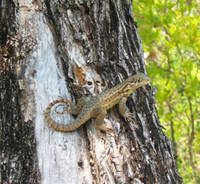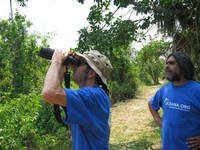April 26, 2005
Observing, on land and sea.
Yesterday we ended the day with excellent news: We can fix the motor in this place. Fortunately, David found out that, by mistake, the Fort Lauderdale mechanics connected the hose that runs underneath the flotation line to the motor, causing it to be flooded”, comments Carlos Pérez. We breathe a sigh of relief, or else, the “mistake” would have caused us a delay of many days and we would have been forced to give up on important projects that were planned months ago, like the crossing to the Sargasso Sea.
In addition to the technical problems we have endured, expedition members are a little disappointed by the poor result obtained in our search for turtles. Patience. The only thing we can do is continue diving until we find them. Today we are diving in front of the turtle nesting beaches in Pelican Cay, where we went with the help of Louis, Brendal’s young collaborator. The process of laying eggs costs turtles a great use of energy and in order to rest and gain back strength, they go to the nearby reef areas where they feel safe and undisturbed. We know they are there, we came to see them and we have followed them…but they are always faster than our auxiliary boat and faster than the divers. Except for local guides, none of us has seen them in detail. Neither has the two diving teams formed by Mar and Houssine, Annie and Sole nor those of us who practice snorkel (Ricardo, Indi and I).
In one of the reefs, we found out that many Elkhorn corals (Acropora palmata) were destroyed by huracanes, so frequent in this area. We also were fortunate to see a small coral extension of Staghorn coral (Acropora cervicornis)

Curly tail Iguanas
Brendal had promised us dinner on the beach; we would eat fish caught in the area: porgy, dusky grouper and pez cerdo. As soon as Ricardo, Director of Research, Indi, the naturalist cook and I went ashore, to a place called Manjack Cay, we went on a road that runs all along the cay. At every step of the way we could see small iguanas measuring no more than 25 centimeters long-the locals call them “curly tails”, as they curl their tails in the shape of a snail. They sit looking curious and daring on the tree branches, and with a little savvy, I was able to photograph some of them.
The birds also seem to be undisturbed. Indi identifies a Warbler that flies around us for a long while, oblivious to human presence. There are also humming birds, but these fly much higher. We even saw owl pellets with skeletal remains of a small rodent. We could see the skull, molars and part of the incisors, perfectly. Raptor species swallow their prey whole and the parts they cannot digest, like hair and bones, they regurgitate.

As for me, after several days of practicing snorkel, I can already distinguish the attractive and colorful parrotfish, with their lips tinted dark; the Lined Butterflyfish; Yellow Boxfish, Browse Fish, and a few squirrel fish. During one of these dives, as we were coming back to the ship, I was sure I saw a shark, across, at some five meters below me. I swiftly turned around to warn my companions who came behind, but they did not see it anymore.
Apart from Nassau dusky groupers other species that are included in the priority list to be documented during this Transoceanic Expedition are turtles, sharks and stingrays. Because of strict safety reasons, when we enter their territories, only divers will participate in submersion sessions.
Ouch! As I write, after dinner, small, almost invisible mosquitoes are biting us to death!

